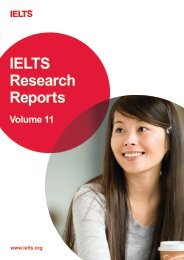An investigation of the process of writing IELTS Academic Reading ...
An investigation of the process of writing IELTS Academic Reading ...
An investigation of the process of writing IELTS Academic Reading ...
You also want an ePaper? Increase the reach of your titles
YUMPU automatically turns print PDFs into web optimized ePapers that Google loves.
<strong>An</strong>thony Green and Roger Hawkey<br />
robots appear more human-like are explored. As in Victoria’s text, <strong>the</strong>re is an element <strong>of</strong> evaluation<br />
and different points <strong>of</strong> view are quoted.<br />
Mary was concerned with <strong>the</strong> au<strong>the</strong>nticity <strong>of</strong> her text and sought to make as few changes as possible in<br />
adapting it for <strong>IELTS</strong>. Like Mathilda, Mary, who made 30 edits in all, made a number <strong>of</strong> changes to<br />
<strong>the</strong> vocabulary <strong>of</strong> her text. These included changing ‘careering’ to ‘moving’; ‘resplendent in’ to<br />
‘wearing’; ‘myriad’ to ‘a multitude <strong>of</strong>’; ‘don’ to ‘put on’ and two instances <strong>of</strong> ‘doppelgänger’ to<br />
‘computerised double’ and ‘robotic twin’. As in Mathilda’s text, <strong>the</strong>se changes all involved replacing<br />
relatively infrequent words with more frequent alternatives, although, reflecting <strong>the</strong> nature <strong>of</strong> <strong>the</strong> text,<br />
none <strong>of</strong> <strong>the</strong>se appear particularly technical to <strong>the</strong> field <strong>of</strong> robotics. Mary’s changes reduced <strong>the</strong><br />
proportion <strong>of</strong> both AWL and infrequent words while increasing <strong>the</strong> proportion <strong>of</strong> very frequent words<br />
(Figure 1 and Figure 2).<br />
Mary explained that <strong>the</strong> need to reduce <strong>the</strong> length <strong>of</strong> <strong>the</strong> text led her to remove contextualising points<br />
<strong>of</strong> detail such as <strong>the</strong> identity <strong>of</strong> a researcher’s university (‘…who research human-computer interaction<br />
at <strong>the</strong> Georgia Institute <strong>of</strong> Technology in Atlanta’), reporting ‘…presented at <strong>the</strong> Human-Robot<br />
Interaction conference earlier this month in Amsterdam, <strong>the</strong> Ne<strong>the</strong>rlands’, or <strong>the</strong> location <strong>of</strong> a research<br />
facility (‘in Germany’) and references to o<strong>the</strong>r texts ‘(New Scientist, 12 October 2006, p 42)’.<br />
Mary also chose to summarise stretches <strong>of</strong> text. For example, she reduced ‘But Hiroshi Ishiguro <strong>of</strong><br />
Osaka University in Japan thinks that <strong>the</strong> sophistication <strong>of</strong> our interactions with robots will have few<br />
constraints. He has built a remote-controlled doppelgänger, which fidgets, blinks, brea<strong>the</strong>s, talks,<br />
moves its eyes and looks eerily like him. Recently he has used it to hold classes…’ to ‘Scientist<br />
Hiroshi Ishiguro has used a robotic twin <strong>of</strong> himself to hold classes…’ However, she chose to introduce<br />
this section <strong>of</strong> <strong>the</strong> text with three sentences <strong>of</strong> her own composition, ‘Whe<strong>the</strong>r robots can really form<br />
relationships with humans and what <strong>the</strong>se can be is much disputed. Only time will really tell.<br />
However, despite <strong>the</strong> negative criticism <strong>the</strong>re is one scientist with strong evidence for his view.’ This<br />
would seem to reflect <strong>the</strong> focus <strong>of</strong> her tasks on <strong>the</strong> identification <strong>of</strong> views expressed by different<br />
experts mentioned in <strong>the</strong> text.<br />
There is evidence that Mary was aware <strong>of</strong> <strong>the</strong> need to avoid potentially sensitive topics in <strong>IELTS</strong> when<br />
choosing her cuts as well as in <strong>the</strong> initial text selection. Three <strong>of</strong> <strong>the</strong> four sentences in a paragraph<br />
concerning <strong>the</strong> emotional attachment formed by American soldiers to robots employed in <strong>the</strong> Iraq war<br />
were deleted from <strong>the</strong> <strong>IELTS</strong> text.<br />
Although expressing <strong>the</strong> most concern for au<strong>the</strong>nticity and favouring a light editorial touch, <strong>of</strong> all <strong>the</strong><br />
writers, Mary was <strong>the</strong> only one to substantially reorder her text. She reported that she had found <strong>the</strong><br />
original text poorly organised. She wanted to focus in her questions on opinions expressed by different<br />
researchers, but found that <strong>the</strong>se were distributed across paragraphs and felt that her questions would<br />
be more effective if <strong>the</strong> paragraphing was addressed.<br />
The first four sentences <strong>of</strong> <strong>the</strong> fifth paragraph in her source text, which quotes <strong>the</strong> views <strong>of</strong> a named<br />
researcher, are cut, and appended to <strong>the</strong> sixth paragraph. The final sentence is removed altoge<strong>the</strong>r. The<br />
change, which brings toge<strong>the</strong>r two quotations from <strong>the</strong> same expert, reflects Mary’s words (see above)<br />
concerning <strong>the</strong> influence <strong>of</strong> <strong>the</strong> task type (matching views to protagonists) and <strong>the</strong> need to avoid<br />
diffusing <strong>the</strong> views <strong>of</strong> <strong>the</strong> experts across <strong>the</strong> text. Taken toge<strong>the</strong>r, Mary’s changes had <strong>the</strong> effect <strong>of</strong><br />
making <strong>the</strong> text easier to read according to both <strong>the</strong> Flesch-Kincaid grade level estimate and <strong>the</strong> Coh-<br />
Metrix readability formula (Figure 3).<br />
We now turn our attention to <strong>the</strong> texts submitted by <strong>the</strong> experienced item writers.<br />
<strong>IELTS</strong> Research Reports Volume 11 www.ielts.org 32

















